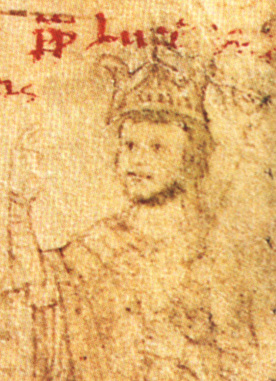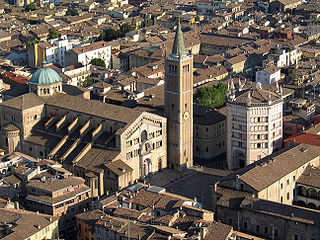Biography
Sicardus was born in Cremona, probably to the Casalaschi family, and probably in the 1150s. [1] His brother Bocardus is sometimes called Bocardus Casalascus. [2]
He studied law in Bologna and Mainz, though he could not take a degree from Mainz since the university had not yet been founded or received a charter.
Sicardus himself records in his Cronica that he received minor holy orders in 1179 from Bishop Offredus of Cremona (1168–1185). [3]
In 1180, while living in Mainz, he composed the Summa canonum. [4]
He returned to Cremona. He was ordained a subdeacon by Pope Lucius III in 1183, and was sent to the emperor Frederic Barbarossa, to arrange a meeting between the emperor and the pope. [5]
Bishop Offredus died on 9 August 1185, and Sicardus was elected bishop of Cremona, [6] before 23 August 1185, when he signed an agreement with the Canons of the cathedral. [7] At the same time, the Emperor rebuilt and fortified the city of Crema, and laid the city of Cremona under the imperial ban. [8]
Early in 1188, Sicard made the journey to Germany, [9] to beg the Emperor Frederick to allow the Cremonans to rebuild Castromanfredi. The emperor refused. [10] Therefore, on April 18, 1188, Bishop Sicard laid the first stone of a new castle to defend Cremona. This was an outpost in the northwest, toward Crema, the Castrum Leonis, today Castelleone. Sicard and the people also built a transport ship, intended to carry supplies to the troops fighting in the Holy Land. [11] In the same year, he fell afoul of the papacy. He had torn down and carried away the stones of a chapel on allodial land belonging to the convent of nuns at S. Julia in Brescia. Two cardinal legates, Soffredus and Petrus, ordered a trial. The bishop apparently lost, since Pope Clement III, who had refused appeals, appointed two commissioners on 30 March 1190 to conclude the business even in the face of further delaying tactics. [12]
On 19 January 1191, Bishop Sicardus was at Lodi, where he met King Henry, Barbarossa's son, who was going to Rome for his coronation. [13] In 1193, in a reply to an inquiry from Bishop Sicardus, Pope Celestine III assured Sicardus that he had the right to judge suits of clerics, without appeal, provided that the sum involved was less than 40 solidi, and provided that the bishop had no personal interest in the suit. [14]
On 4 June 1196, Pope Celestine III issued a mandate to Bishop Sicardus, to intervene against the neighbors and patrons of the church of Santa Croce in Cremona, which belonged de jure to the monastery of Nonantola; they had detained the prior and chaplain unlawfully, and should be warned to return the church to the Abbot and monastery of Nonantola and to make restitution for the vineyard belonging to the church which they had plundered. [15] The bishop was in Pavia on 26 August 1196, where he subscribed a charter of Henry VI. [16] Henry died on 28 September 1197, and Pope Celestine on 8 January 1198. In northern Italy, one petty war after another disturbed the political and ecclesiastical scene, Milan and Cremona struggling again over Crema, while in Germany there were two contenders for the imperial crown, Otto of Brunswick and Philip of Swabia. [17] Innocent III was elected pope on 8 January 1198. [18]
In 1203 he followed the papal legate Cardinal Peter of Capua to the East during the Fourth Crusade. As they were returning in 1204, by way of Constantinople, to make a report on operations in the east, Sicardus conducted ordinations in Hagia Sophia on the legate's invitation, on 18 December 1204. How long he remained in Constantinople is not known, but the Legate, Cardinal Peter, received an angry letter from Pope Innocent III, dated 17 February 1205, berating him for leaving his post in the Holy Land. [19]
Sicardus had certainly returned to Cremona by 16 December 1205, when he received the rights of patronage over the church of All Saints in Cremona from its former patron. [20] In 1206, he was appointed, along with the Archdeacon and Canon Peter of Parma, to a commission against Mantua, which was building a bridge over the Zara River and erecting a fort, which threatened Reggio; the commission was granted power to impose an interdict on Mantua. [21]
He supported Frederick II against the Holy Roman Emperor Otto IV of Braunschweig.
Sicardo died in Cremona on 8 June 1215. [22] Two days before his death, however, several Canons issued a call for an electoral meeting to choose his successor. They duly met and elected the Archpriest Dompnettum. One of the Canons chose to appeal to the Holy See. When Pope Innocent heard of the circumstances of the election, he immediately quashed the election, and on 3 December 1216, announced that he had consecrated a new bishop for Cremona. [23]

Pope Lucius III, born Ubaldo Allucingoli, reigned from 1 September 1181 to his death in 1185. Born of an aristocratic family of Lucca, prior to being elected pope, he had a long career as a papal diplomat. His papacy was marked by conflicts with Holy Roman Emperor Frederick I, his exile from Rome and the initial preparations for the Third Crusade.
Pope John X was the bishop of Rome and nominal ruler of the Papal States from March 914 to his death. A candidate of the counts of Tusculum, he attempted to unify Italy under the leadership of Berengar of Friuli, and was instrumental in the defeat of the Saracens at the Battle of Garigliano. He eventually fell out with Marozia, who had him deposed, imprisoned, and finally murdered. John’s pontificate occurred during the period known as the Saeculum obscurum.

Anselm of Lucca, born Anselm of Baggio, was a medieval bishop of Lucca in Italy and a prominent figure in the Investiture Controversy amid the fighting in central Italy between Matilda, countess of Tuscany, and Emperor Henry IV. His uncle Anselm preceded him as bishop of Lucca before being elected to the papacy as Pope Alexander II and so he is sometimes distinguished as Anselm the Younger or Anselm II.

The Diocese of Vicenza is a Latin diocese of the Catholic Church in Italy. It is located in the region of the Veneto, and is the capital of the Province of Vicenza, approximately 60 km west of Venice, and around 45 km east of Verona. The diocese was in existence before 590. Vicenza was a suffragan of the Patriarchate of Aquileia until 1751. In 1751 it was transferred to the ecclesiastical province of Udine. In 1818, upon the dissolution of the ecclesiastical province of Udine, Vicenza was made it a suffragan of the Patriarchate of Venice.

Peter of Capua was an Italian scholastic theologian and prelate. He served as cardinal-deacon of Santa Maria in Via Lata from 1193 until 1201 and cardinal-priest of San Marcello al Corso from 1201 until his death. He often worked as a papal legate. He wrote several theological works and was a patron of his hometown of Amalfi.

Albinus was an Italian Cardinal of the late twelfth century. A native of Milan, or perhaps of Gaeta, he became an Augustinian regular canon.

The Diocese of Cremona is a Latin Church ecclesiastical territory or diocese of the Catholic Church in northern Italy. It is a suffragan diocese in the ecclesiastical province of the metropolitan Archdiocese of Milan. The bishop of Cremona's cathedra is in the Cathedral of the Assumption of the Virgin Mary.

The Diocese of Parma is a Latin diocese of the Catholic Church. It has properly been called Diocese of Parma-Fontevivo since 1892. The bishop's seat is in Parma Cathedral. The diocese is a suffragan of the Archdiocese of Modena-Nonantola.

The Diocese of Lodi is a Latin diocese of the Catholic Church that existed since the 4th century; it is a suffragan of the Archdiocese of Milan.

The Archdiocese of Salzburg is a Latin Church archdiocese of the Catholic Church in Austria. The archdiocese is one of two Austrian archdioceses, serving alongside the Archdiocese of Vienna.

The Archdiocese of Ferrara-Comacchio is a Latin Church archdiocese of the Catholic Church. It has existed since 1986, when the diocese of Comacchio was combined with the historical archdiocese of Ferrara. It is a suffragan of the archdiocese of Bologna.
Praepositinus was an Italian scholastic philosopher and theologian. He was a liturgical commentator, and supported a res-theory of belief. He discussed intentional contexts.
John of Crema was an Italian papal legate and cardinal. He was a close supporter of Pope Callistus II.

Henry IV was Holy Roman Emperor from 1084 to 1105, King of Germany from 1054 to 1105, King of Italy and Burgundy from 1056 to 1105, and Duke of Bavaria from 1052 to 1054. He was the son of Henry III, Holy Roman Emperor—the second monarch of the Salian dynasty—and Agnes of Poitou. After his father's death on 5 October 1056, Henry was placed under his mother's guardianship. She made grants to German aristocrats to secure their support. Unlike her late husband, she could not control the election of the popes, thus the idea of the "liberty of the Church" strengthened during her rule. Taking advantage of her weakness, Archbishop Anno II of Cologne kidnapped Henry in April 1062. He administered Germany until Henry came of age in 1065.

Rudolf of Wied was anti-Archbishop of Trier from 1183–1189. He was a supporter of the Holy Roman Emperor Frederick I Barbarossa in the late twelfth century phase of the Investiture Controversy.

Pietro Diani was an Italian cardinal. The name "Diana" is incorrect; he signs himself Petrus Dianus.

Thomas of Capua, also called Tommaso di Eboli, was an Italian prelate and diplomat. He served as the archbishop-elect of Naples from 1215 until 1216 and then as a cardinal until his death. He administered the diocese of Albano between 1218 and 1222 and was the papal legate in the kingdom of Italy from November 1236 until October 1237. He was the most important of Pope Gregory IX's negotiators with the Emperor Frederick II between 1227 and 1237.
Gerardo da Sesso was an Italian monk, bishop and cardinal of the Catholic Church.

Laborans de Pontormo was an Italian cardinal. His name in Italian is Laborante. He was a native of Pontormo, a suburb of the city of Florence on the left bank of the Arno River. He was a distinguished jurist and influential writer on canon law.

Ardicio de Rivoltela was a cardinal of the Roman Catholic Church. He was a native of Piadena (Platina), in the diocese of Cremona in Lombardy. The appellation "de Rivoltela" is mentioned only once, and its significance is unclear.












